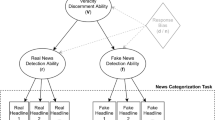Abstract
Rational models have difficulty explaining low levels of demand for long-term care insurance. We posit that insurers have framed the need for insurance in a manner that unintentionally promotes risk-seeking behavior (i.e., high probability loss frame), and that alternative frames can better promote willingness to insure. We further posit that emotional frames are more effective than rational risk frames in promoting willingness to pay. Survey evidence supports these hypotheses: emotional narrative frames are associated with greatest willingness to pay, and the high probability loss frame was associated with among the lowest average amounts willing to pay.
Similar content being viewed by others
References
America’s Health Insurance Plans and LifePlans, Inc. 2012. Who buys long-term care insurance in 2010–2011? A twenty-year study of buyers and non-buyers (in the Individual Market).
Bandura, A. 1977. Self-efficacy: Toward a unifying theory of behavioral change. Psychological Review 84(2): 191.
Brown, J.R. and A. Finkelstein. 2004. The interaction of public and private insurance: Medicaid and the long-term care insurance market. National Bureau of Economic Research, Working Paper 10989.
Brown, J.R. and A. Finkelstein. 2007. Supply or demand: Why is the market for long-term care insurance so small? National Bureau of Economic Research, Working Paper 10782.
Brown, J.R., J.R. Kling, S. Mullainathan, and M.V. Wrobel. 2008. Why don’t people insure late life consumption? A framing explanation of the under-annuitization puzzle. American Economic Review 98(2): 304–309.
Cacioppo, J.T., and R.E. Petty. 1982. The need for cognition. Journal of Personality and Social Psychology 42(1): 116–131.
Cutler, J.A., B. Spillman, and E.J. Tell. 2010. Private financing of long term care: Market penetration and market potential. Paper presented at Academy Health ARM Conference, Boston, MA.
Davis, M.H. 1983. Measuring individual differences in empathy: Evidence for a multidimensional approach. Journal of Personality and Social Psychology 44(1): 113–126.
De Wit, J.B., E. Das, and R. Vet. 2008. What works best: Objective statistics or a personal testimonial? An assessment of the persuasive effects of different types of message evidence on risk perception. Health Psychology 27(1): 110.
Harlow, R.E., R.S. Friedman, T.E. Higgins, A. Taylor, and J. Shah. 2001. Promotion and prevention experiences as a personality variable. Columbia: Columbia University.
Hastings, G., M. Stead, and J. Webb. 2004. Fear appeals in social marketing: Strategic and ethical reasons for concern. Psychology & Marketing 21(11): 961–986. doi:10.1002/mar.20043.
Hershey, D.A., and J.C. Mowen. 2000. Psychological determinants of financial preparedness for retirement. The Gerontologist 40(6): 687–697.
Janis, I.L. 1967. Effects of fear arousal on attitude change: Recent developments in theory and experimental research. Advances in Experimental Social Psychology 3: 166–224.
Kahneman, D. 2011. Thinking, fast and slow. New York, NY: Farrar, Straus and Giroux.
Kahneman, D., and A. Tversky. 1984. Choices, values, and frames. American Psychologist 39(4): 341–350.
Kaplan, R. 2007. Retirement planning’s greatest gap: Funding long-term care. Lewis & Clark Law Review 11(407). https://ssrn.com/abstract=993179.
Kunreuther, H. 1978. Disaster insurance protection: Public policy lessons. New York, NY: Wiley.
McGrew, K. 2000. Impossible selves? Challenges and strategies for encouraging individual long-term care planning. Oxford, OH: Scripps Gerontology Center, Miami University.
Merlis, M. 2003. Private long-term care insurance: Who should buy it and what should they buy? Washington, DC: Henry J. Kaiser Family Foundation. http://www.kff.org/insurance/loader.cfm?url=/commonspot/security/getfile.cfm&PageID=14370.
Norton, E. 2000. Long-term care. In Handbook of health economics, ed. AJ Culyer and JP Newhouse, Vol. 1, Ch. 17. Amsterdam: Elsevier Science.
O’Keefe, D.J., and J.D. Jensen. 2007. The relative persuasiveness of gain-framed and loss-framed messages for encouraging disease prevention behaviors: A meta-analytic review. Journal of Health Communication 12(7): 623–644.
Pauly, M.V. 1990. The rational non-purchase of long-term-care insurance. Journal of Political Economy 98(1): 153–168.
Rothman, A.J., P. Salovey, C. Antone, K. Keough, and C. Drake Martin. 1993. The influence of message framing on health behavior. Journal of Experimental Social Psychology 29(5): 408–433.
Salovey, P., T.R. Schneider, and A.M. Apanovitch. 2002. Message framing in the prevention and early detection of illness. In The persuasion handbook: Theory and practice, ed. J.P. Dillard, and M. Pfan, 391–406. Thousand Oaks, CA: Sage Publications.
Sloan, F.A., and E.C. Norton. 1997. Adverse selection, bequests, crowding out, and private demand for insurance: Evidence from the long-term care insurance market. Journal of Risk and Uncertainty 15(3): 201–219.
Slovic, P. 2010. The more who die, the less we care. In The irrational economist: Making decisions in a dangerous world, ed. P. Slovic, and E. Michel-Kerjan, 30–40. New York: Public Affairs Press.
Small, D.A., and G. Loewenstein. 2003. Helping a victim or helping the victim: Altruism and identifiability. The Journal of Risk and Uncertainty 26(1): 5–16.
Small, D.A., G. Loewenstein, and P. Slovic. 2007. Sympathy and callousness: The impact of deliberative thought on donations to identifiable and statistical victims. Organizational Behavior and Human Decision Processes 102(2): 143–153.
Strathman, A., F. Gleicher, D.S. Boninger, and C.S. Edwards. 1994. The consideration of future consequences: Weighing immediate and distant outcomes of behavior. Journal of Personality and Social Psychology 66(4): 742–752.
van Westendorp, P.H. 1976. NSS price sensitivity meter (PSM)—A new approach to study consumer perception of prices. In ESOMAR Congress (25th), 139–166, Venice.
Wiener, J.M., J. Tilly, and S.M. Goldenson. 2000. Federal and state initiatives to jump start the market for private long-term care insurance. The ElderLaw Journal 8(1): 57–99.
Author information
Authors and Affiliations
Corresponding author
Rights and permissions
About this article
Cite this article
Pincus, J., Hopewood, K. & Mills, R. Framing the decision to buy long-term care insurance: losses and gains in the context of statistical and narrative evidence. J Financ Serv Mark 22, 33–40 (2017). https://doi.org/10.1057/s41264-017-0019-4
Revised:
Published:
Issue Date:
DOI: https://doi.org/10.1057/s41264-017-0019-4




